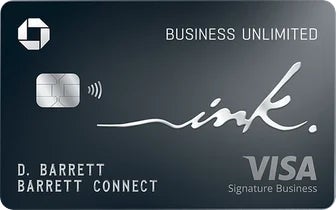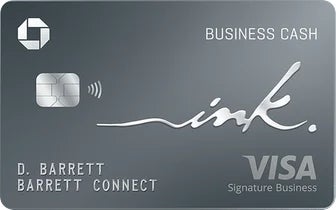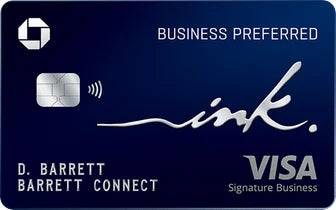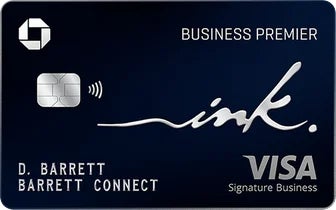KEY LINKS:
- Chase Ink Business Unlimited® Credit Card – Earn $750 bonus cash back after you spend $6,000 on purchases in the first 3 months from account opening. $0 annual fee
- Chase Ink Business Cash® Credit Card – Earn $350 when you spend $3,000 on purchases in the first three months and an additional $400 when you spend $6,000 on purchases in the first six months after account opening. $0 annual fee
- Chase Ink Business Preferred® Credit Card – Earn 120,000 bonus points after you spend $8,000 on purchases in the first 3 months from account opening. $95 annual fee
- Ink Business Premier® Credit Card – Earn $1,000 bonus cash back after you spend $10,000 on purchases in the first 3 months from account opening. $195 annual fee
I’ve often said that the best way to get a good number of points is through judicious credit card signups. If you find that you are putting all of your spending on your one airline or rewards credit card but not actually getting enough points for any trips, you might want to take a closer look at periodically signing up for new credit cards. As long as you have the financial ability and discipline to pay off your credit cards in full, each and every month, I think that most people could sign up for a new card every few months without having any real impact on your credit score.
(SEE ALSO: 5 myths about credit and your credit score)
Today I wanted to take a look at four of the Chase Ink credit cards. All of them have increased signup bonuses worth several hundred dollars and maybe even close to $1,000 or more. All of these cards are considered “small business” credit cards, but you may have a business even if you don’t think you do. And I would say that if you are ignoring the small business cards and only applying for personal credit cards, you are doing yourself a disservice by passing up on half of the available credit card bonus offers.
Chase Ink Business Unlimited® Credit Card
The first card to look at is the Chase Ink Unlimited. The Ink Unlimited has a very simple earning structure. You’ll get 1.5% cash back per dollar spent on the card. If you don’t have a premium Chase card (like the Sapphire Reserve or Ink Preferred), then you can only redeem your cash back directly. But if you do have a premium card, you can transfer your Chase points that you earn with the Ink Unlimited and get 25% or 50% extra value.
- Earn $750 bonus cash back after you spend $6,000 on purchases in the first 3 months from account opening
- 1.5% cash back on all purchases
- 0% Intro APR on Purchases 12 months. Regular APR is 18.49% – 24.49% Variable
- Primary Car Rental Damage Insurance when traveling for business (so you can decline the car rental company’s insurance)
- $0 annual fee
Chase Ink Business Cash® Credit Card
The Chase Ink Cash is another no-fee option. Rather than earning 1.5% cash back per dollar, you’ll get 5% at office supply stores and on internet, cable and phone services, and 2% cash back at gas stations and restaurants. So depending on your spending patterns, you may find that you’ll come out ahead with the Ink Cash instead of the Ink Unlimited. You can also consider having both cards – that way you can use the Ink Cash where it gets a spending bonus and the Ink Unlimited everywhere else.
Just like with the Ink Unlimited, if you don’t have a premium Chase card (like the Sapphire Reserve or Ink Preferred), then you can only redeem as cash back. But if you do have a premium card, you can transfer your Chase points that you earn with the Ink Unlimited and get 25% or 50% extra value.
- Earn $350 when you spend $3,000 on purchases in the first three months and an additional $400 when you spend $6,000 on purchases in the first six months after account opening.
- 5% cash back at office supply stores and on internet, cable and phone services (up to $25,000 per year combined)
- 2% cash back at gas stations and restaurants (up to $25,000 per year combined)
- 1% cash back on all other purchases
- Primary Car Rental Damage Insurance when traveling for business (so you can decline the car rental company’s insurance)
- $0 annual fee
Chase Ink Business Preferred® Credit Card
The Chase Ink Preferred comes with a $95 annual fee and is considered one of Chase’s premium travel cards. It also comes with a higher initial welcome bonus (120,000 Ultimate Rewards points) but also has a higher spending requirement
- Earn 120,000 bonus points after you spend $8,000 on purchases in the first 3 months from account opening
- 3X points on shipping and advertising purchases, Internet, cable and phone services and travel (on the first $150,000 of purchases, then 1X)
- Redeem points for 1.25 cents per point through the Chase travel portal (25% bonus)
- Ability to transfer your Ultimate Rewards points to Chase travel partners including United Airlines, Hyatt Hotels and Southwest Airlines
- Trip Cancellation and Trip Interruption Insurance
- Primary Car Rental Damage Insurance when traveling for business (so you can decline the car rental company’s insurance)
- Cell Phone protection (if you pay your bill with the card)
- $95 annual fee
Chase Ink Business Premier® Credit Card
The Chase Ink Premier is the newest of the four Chase Ink cards and comes with a $195 annual fee. It also comes with a higher initial welcome bonus ($1,000) but also has a higher spending requirement ($10,000 in the first 3 months of having the card). The Chase Ink Premier is a bit different than the other Ink cards as it’s meant as a true cashback card.
The Chase Ink Premier is not like the other Chase Ink cards that earn Ultimate Rewards. The rewards it earns are straight cashback and can’t be combined with Ultimate Rewards points that are earned by other Chase Ink cards.
- Earn $1,000 bonus cash back after you spend $10,000 on purchases in the first 3 months from account opening
- 2.5% cash back on large purchases over $5,000
- 2% cash back on all other business purchases with no limit
- 5% cash back on travel purchased through Chase Travel℠
- Can only redeem your points for cash back and can’t combine
- Trip Cancellation and Trip Interruption Insurance
- Primary Car Rental Damage Insurance when traveling for business (so you can decline the car rental company’s insurance)
- Cell Phone protection (if you pay your bill with the card)
- $195 annual fee
Which Chase Ink Card is Best?
Deciding which of these four Chase Ink credit cards is best for you will depend on your particular spending patterns. Of course $8,000 or $10,000 spending in only 3 months is quite a bit, so if you don’t feel like you can make that, the Ink Preferred and Ink Premier may not be great options for you. Even $6,000 in 3 months could be challenging for some people. If you can make the spending targets, I would consider the Ink Preferred if you don’t have another premium Chase credit card. Other than that, I would probably get the Ink Cash first and then the Ink Unlimited. Personally, I have both the Ink Cash and Ink Unlimited (along with the Chase Sapphire Preferred® Card).
- Chase Ink Business Unlimited® Credit Card – Earn $750 bonus cash back after you spend $6,000 on purchases in the first 3 months from account opening. $0 annual fee
- Chase Ink Business Cash® Credit Card – Earn $350 when you spend $3,000 on purchases in the first three months and an additional $400 when you spend $6,000 on purchases in the first six months after account opening. $0 annual fee
- Chase Ink Business Preferred® Credit Card – Earn 120,000 bonus points after you spend $8,000 on purchases in the first 3 months from account opening. $95 annual fee
- Ink Business Premier® Credit Card – Earn $1,000 bonus cash back after you spend $10,000 on purchases in the first 3 months from account opening. $195 annual fee
What about you? Do you have any of the Chase Ink cards? Which one do you think is best?
This site is part of an affiliate sales network and receives compensation for sending traffic to partner sites, such as thepointsguy.com. This may impact how and where links appear on this site. Responses are not provided or commissioned by the bank advertiser. Some or all of the card offers that appear on the website are from advertisers and that compensation may impact on how and where card products appear on the site. Any opinions expressed in this post are my own, and have not been reviewed, approved, or endorsed by my advertising partners and I do not include all card companies, or all available card offers. Terms apply to American Express benefits and offers and other offers and benefits listed on this page. Enrollment may be required for select American Express benefits and offers. Visit americanexpress.com to learn more. Other links on this page may also pay me a commission - as always, thanks for your support if you use them
User Generated Content Disclosure: Points With a Crew encourages constructive discussions, comments, and questions. Responses are not provided by or commissioned by any bank advertisers. These responses have not been reviewed, approved, or endorsed by the bank advertiser. It is not the responsibility of the bank advertiser to respond to comments.






 Dan Miller travels with his wife and 6 (SIX!) children. He loves to help families travel for free / cheap, especially larger families. If you are looking for help, drop him an email at
Dan Miller travels with his wife and 6 (SIX!) children. He loves to help families travel for free / cheap, especially larger families. If you are looking for help, drop him an email at 
Nice blog, keep it up!
Such a great article, thank you for sharing this blog.
How many Ink Preferred cards can a person hold at one time? Thanks for giving an answer.
I don’t know that there is a specific answer for that. I know I have heard talks of people getting many of them, though I was denied for (an additional) one a few months ago.